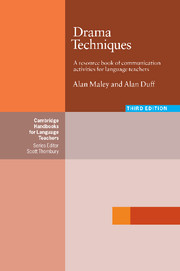Book contents
- Frontmatter
- Contents
- Thanks and acknowledgements
- Introduction
- 1 Getting ready
- 2 Observation
- 3 Working with mime
- 4 Working with the voice
- 5 Working with objects
- 6 Working with visuals
- 7 Working with the imagination
- 8 Working from/into words, phrases, sentences
- 9 Working from/into texts
- 10 Working from/into scenarios and scripts
- 11 Into Performance
- Bibliography
- Index
6 - Working with visuals
Published online by Cambridge University Press: 03 May 2010
- Frontmatter
- Contents
- Thanks and acknowledgements
- Introduction
- 1 Getting ready
- 2 Observation
- 3 Working with mime
- 4 Working with the voice
- 5 Working with objects
- 6 Working with visuals
- 7 Working with the imagination
- 8 Working from/into words, phrases, sentences
- 9 Working from/into texts
- 10 Working from/into scenarios and scripts
- 11 Into Performance
- Bibliography
- Index
Summary
‘A picture is better than a thousand words’, goes the old saying. In language teaching and drama we could equally well say, ‘A picture can stimulate a thousand words’. One of the reasons for this is that different people ‘see’ the same picture differently. We all interpret pictures in different ways, partly as a result of associations based on different past experiences. This is a rich resource for discussion.
Using visuals is clearly an advantage for those students with visual dominance, but it can be helpful for all students to receive inputs through more than one sensory channel. The more channels we can use, the better the chance that the information will get through and be incorporated into the pattern of existing knowledge.
Visuals, of course, do not simply mean pictures ‘out there’. They also include the visualisation which takes place ‘in here’ – inside our own heads. Indeed, these inner visualisations in the mind's eye may be even more powerful than the ones we meet outside in the world. This is also true of pictures we ourselves draw, however poor we may consider ourselves as artists.
In this chapter, activities will be suggested which touch on description, interpretation, association and visualisation as ways in to language learning through drama.
On a practical note, it is well worth building up a collection of pictures in the various categories suggested by the activities: portraits, pictures with a lot of activity going on, pictures with two people interacting, etc.
- Type
- Chapter
- Information
- Drama TechniquesA Resource Book of Communication Activities for Language Teachers, pp. 116 - 144Publisher: Cambridge University PressPrint publication year: 2005



